On a number of occasions, I have talked about my favourite kukri (I own a few!). This is a ten inch sirupate with a half‑guard and a lengthened grip. This is the tool I will grab when SHTF.
What I have not so far discussed is that my kukri is just one half of a double act. It has a Companion!
With the kukri, I carry a small, fixed blade knife. Both are fitted to the same belt, along with a small pouch containing a fire kit, survival blanket and a sharpening stone. Note wrist loops that may be attached to the snap-links to further prevent the chance of loss.
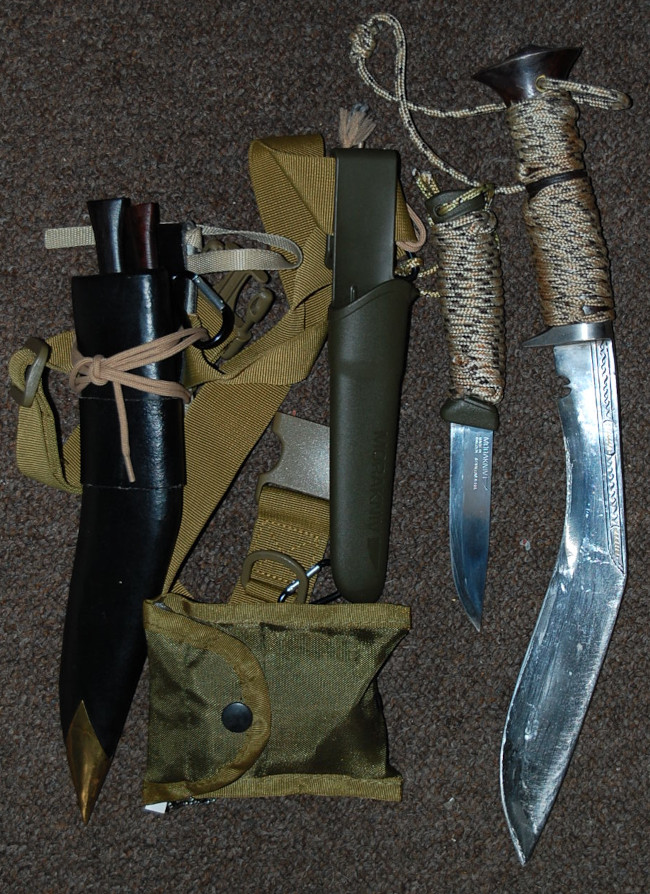
I always have my Swiss Army Knife and mini-Leatherman on me, of course. A small fixed blade is handier, and easier to get clean after a messy task like gutting a fish.
The rationale behind having a pair of fixed blade knives is thus:
Most cutting tasks do not need a large knife. Most such cutting tasks are easier and safer with a small knife. This helps save the edge of the large knife for uses that it is really needed for.
A shorter blade and lighter knife often provides a greater level of control and precision.
A large knife can perform many of the duties of a small knife, but a small knife cannot entirely substitute for a larger blade.
Since the small blade will spend more time out of its sheath than the larger, in theory I am less likely to lose my larger blade. I can manage without the small knife better than I would manage without the larger.
Puukko
When it comes comes to useful small blades, one of the examples that comes to mind is the Finnish puukkot (singular is “puukko”).
Puukkot are about as common as snow in Finland.
Puukkot come in a variety of sizes, but the most commonly encountered are blades of 75 to 100 mm length.
Large production runs and informed buyers means puukkot are produced with good quality blades at reasonable prices. Reasonable in Scandinavia, at least. Crossing the water bumps the price up, but they are still very good knives for the money.
“Fica” knives were apparently once popular with some Russian criminal elements. This is claimed to have inspired the Soviet NR-40 knife. (With its clip point and inverted main edge, the NR-40 has some resemblance to British knuckle-duster knives used in World War One and the Second World War BC41 knife.)
Many puukkot are works of art. Some have handles carved from “curly birch”. Another grip construction utilizes stacks of washers made from reindeer skin or birch bark.
Unmounted puukkot blades are available from some suppliers. If you fancy making your own sheath and grip, I recommend Bo Bergman’s book “Knifemaking”. Not only highly informative, but beautifully photographed and recommended for knife-lovers and other hoplophiles.
I have not yet been to Finland.
I picked up this pair of knives on my last days in Denmark.
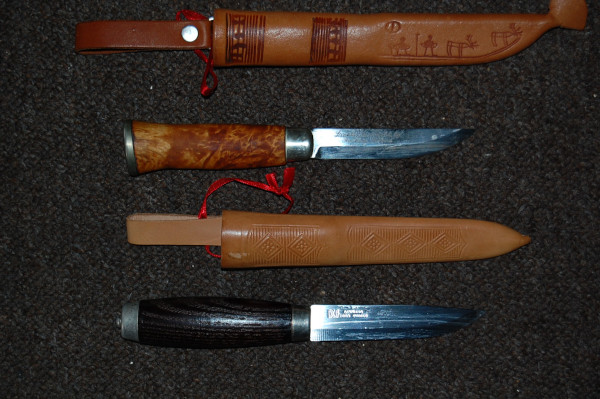
The upper example is Finnish, I believe. The grip is curly birch, with a touch of linseed oil to bring out the grain. Note the button hole in the hanger.
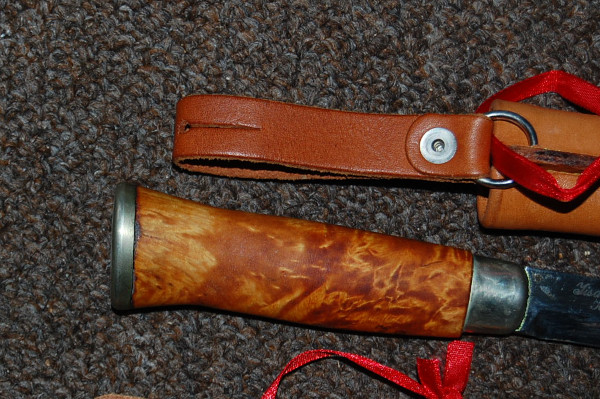
For ease of access, puukkot are often carried suspended from the button of a breast pocket on a shirt or jacket.
This knife is also a good size to fit in a cargo trousers’ thigh pocket. Useful if camping in areas where simpletons will freak out if you wear a belt knife openly.
Note also that these knives usually use a deep sheath that covers most of the grip. Such a sheath is very secure, but does limit the provision of a guard.
Mora Knives
I didn’t know it at the time, but the second knife is Swedish, and made by Mora.
Mora (aka Morakniv) are a Swedish knife manufacturer, and their main products are puukko-type knives.
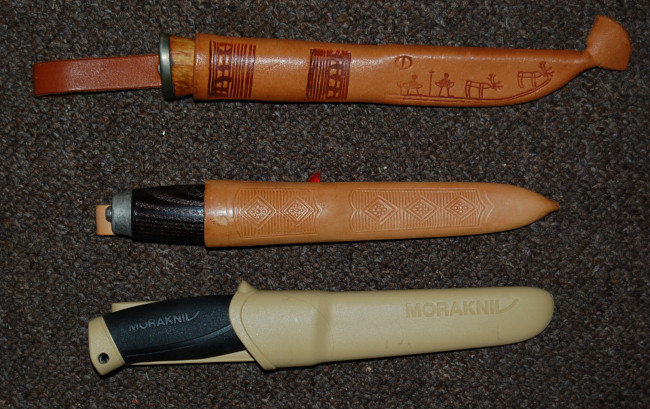
Whether a knife can be a puukko if it is made in Sweden, I will leave for others with more time on their hands to discuss.
Mass production means good quality at very reasonable prices, so Moras are the first choice for many when it comes to choosing a small, fixed blade knife.
Moras are probably at least equal to many knives that are more than five times the price.
The most obvious difference between most Moras and puukkot is that most Moras have handles and sheaths made using plastic rather than wood and leather.
My kukri is complimented by a Mora Companion (model number 860).
I gave another Companion to my girlfriend to compliment her kukri. The Mora proved useful when she was foraging in Sardinia. She also utilised it when gathering seafood when snorkelling. She particularly praised how securely the knife stays in its sheath.
The Companion has a ten centimetre stainless steel blade of a useful and proven configuration.
The plastic sheath is well designed and very secure.The knife positively locks in position and stays in the sheath until you want it. You can quite confidently wear the knife handle down.
A slight bump at the top of the sheath mouth is provided for the thumb to push against if drawing the blade single-handed. You can also push down on the top of the belt-hanger.
The belt hanger is provided with a cut-out for hanging from a button, and the sheath is provided with a drain hole. The hanger itself is a clip, so the sheath may be worn with clip slipped over the top of a pocket or over a jacket edge.
Companions are offered in a wide range of handle and sheath colours. Mine are in a drab green or sand‑colour. Brighter colours are available for those prone to misplacing items.
The Companion, and several other models are available with either stainless steel or carbon steel blades. My preference is for stainless steel, particularly if the knife is going to be stored in a kit and not inspected for some time. Stainless steel is also recommended for fishing knives or any other use that takes you close to salt water.
Carbon steel is better for throwing sparks from ferrite, but is more prone to rusting and discolouration if neglected.
I have various other objects that can throw a spark. My kukri has chakmak and karda. Spark striking is realistically a low priority or me since my EDC includes a butane lighter and there are two in the fire kit on the knife belt. I can even use the striker wheels of the lighters to strike sparks from ferrite rods.
The only modification the Companion really needs is to drill a hole for a wrist loop or lanyard. Since the blade has a rat-tail tang, adding such a channel is a quick and simple task.
I recently brought a Companion for my step-son. Turned out that the most straightforward way to add a lanyard hole was with a 4.5mm screw gimlet. Edges of the hole may be neatened-up by holding it over the flame of a lighter and gently heating.
A screw gimlet is a very prudent addition to your home toolbox.
A criticism sometimes levelled at puukkot is the transition between blade and grip. The forefinger could slip forward and be cut by the edge at the base of the blade. For most uses this is unlikely, but if in a hurry, forgetful or your hands are wet, is a possibility.
The plastic handled Mora’s include a finger guard, and their plastic sheaths are designed to accommodate this feature.
Some of you reading will be discouraged by the reasonable price of a Mora Companion. It cannot be that good a quality at such a low price!
Given how low the price is, I challenge those readers who think this to take a risk and buy yourself one. Then send me a cash donation as penance for doubting my word, shame on you!
Chances are you will probably invest in a couple more Moras. At these prices, you can stash a spare in your car, your tackle box and so on.
Mora Pro Robust
When I heard about the Mora Robust/Pro Robust, I was eager to get one.
It might be a good option for situations when I can only carry a single fixed blade knife.
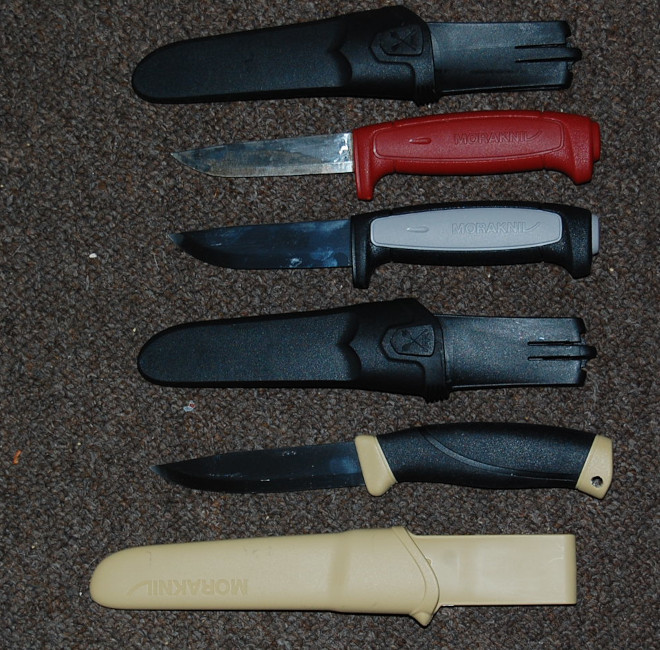
I was expecting a heavier bladed version of the Mora Companion. In fact, the Robust is closer to being a heavier bladed version of my Mora 511 (above, top). The grip is the same shape, and both have 9 cm carbon steel blades. The Pro Robust is described as having a 3.2 mm thick blade while the 511 is listed as 2 mm.
The Pro Robust has a beautifully polished blade. I had elected my 511 as the “kitchen Mora” and used it for something without realising it was a carbon steel blade. Leaving it for a short period without cleaning and drying it has discoloured the finish. Won’t make the same mistake with the Pro Robust.
The Robust and 511 have a more pronounced half-guard than the Companion, and consequently the sheath is a little different. Different in details, but not in features and functionality.
Like the Companion, the Robust (and the 511) lock securely into their sheaths. I have been unable to shake it hard enough to persuade the knife to drop out. I will probably pop a joint before I shake it loose.
Rather than a bulge for the thumb to push against, the top of the sheath mouth has a ridged section for the thumb. The design of the button hanging feature is also different. The most obvious difference is the knob/mushroom structure on the front. A similar feature is seen on some bayonet scabbards and is used to secure the sheath in a frog. It is a convenient structure for the fingertip to push on when drawing the knife single-handed.
There is a thicker bladed version of the Companion available, but I have yet to acquire one. This has a 3.2 mm rather than 2.4 mm thick blade.
Scandi Edge
All of the Mora knives I have owned have arrived already sharp with a good edge. Eventually you will need to resharpen, however.
Traditionally, Scandinavian knives were sharpened with what has become known as a “Scandi edge” or “zero grind”.
What this means is that the primary edge and the bevel are the same. To sharpen, you lay the knife’s bevel flat on the sharpening stone and move the blade back (or forward), depending on your preferred sharpening style.
This is very easy to do, but involves removing a lot of steel with each sharpening. The scandi edge is claimed to produce a very strong edge, useful for some applications.
Modern blade steels tend to be harder and better quality than was available to previous generations, so there is reasonable doubt as to whether a scandi edge is the best choice for modern Mora and puukkot, especially those with laminate or stainless steel blades.
There are plenty of forums and videos on the pros and cons of the scandi edge, so decide for yourself what is best for you. Personally, I sharpen my Mora the same way as I sharpen my other blades.
Bergman’s book suggests sharpening blades with an angle of 10 to 30 degrees, depending on intended application.
For a general purpose knife I would suggest an angle of 22.5 degrees. If you lack a protractor or have trouble visualizing this, fold the corner of a piece of paper in half, then fold it in half again. A quarter of 90 degrees is 22.5.
The “kitchen Mora” responds well to the butcher’s steel I use on my other kitchen blades.
If you are looking for a special present for a knife-lover or outdoorsperson, a traditional puukko is worth considering. Something both beautiful and practical.
Morakniv, aka Frosts, make a wide range of other knives, for the kitchen, the outdoors and for the workshop.